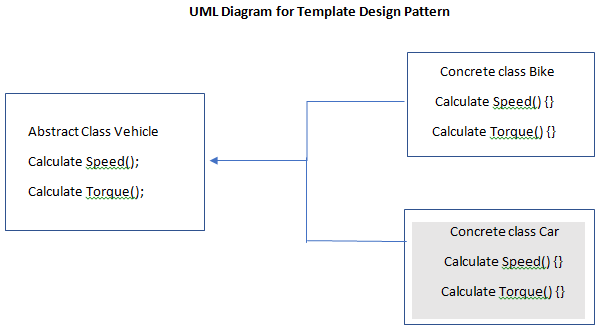
Template in Java
Design patterns help a coder write clean, efficient and non-repeating code with less coupling or dependency among the individual units of operation. Whenever a coder is analyzing the client’s requirement, then the appropriate design pattern for code implementation is the first solution to be taken care of. The code would be scaled later; some additional constraints, if to be added, can be incorporated too.
Design patterns are always chosen with the context of scalability and clean implementation.
We opt for templates when we look to fill them via certain implementations; these are called templates.
And in the coding arena, we use these paradigms under the following kind of business scenarios.
Scenario 1 –
You are supposed to design a web-based solution for Template in Java where you are asked to implement the characteristic properties of a vehicle like its speed calculation formula, torque calculation, etc. So for a bike, it would be different than what would be for a car, and if we see on the scalability perspective, then adding a basic template which just has the outer skeleton of these calculation related methods and then we have just added variants of those implementations in our code, hence making a flexible design. Seeing this template, only a user would get an idea about the functionalities you are offering and look forward to the related classes.
Scenario 2 –
Another cause can be to generate a common template for database classes which you are going to call in your project; you may be using Oracle, MySQL or DB2, and likely in different scenarios of coding, you are looking forward to connecting with them at different instances of time, so in the template, you can feed username, password, get Connection, etc. properties and the extending classes would give the implementation details as you seek.
A Java developer knows how to get this kind of functionality implemented !! Yeah, an abstract class is the right answer; I hope you know that whenever we have scenarios where closely related entities are to be put into a solution, then we choose abstract classes (in otherwise cases, the interfaces also solve our purpose).
Implementing Template in Java
1. Make the base class abstract which incorporates the template methods and the abstract methods too.
2. The template methods are of final nature and won’t change thereafter.
3. The abstract methods are necessary to be implemented via supporting business logic code in the implementation classes.
4. The method could be made abstract in child classes if it has not to be implemented there only.
5. Taking care of exception handling in an appropriate way is also an important scenario.
6. Right choice on what has to be marked abstract and what shall not be.
The methods with bodies in the base class are made to be the final type as they are not to be overridden; like for vehicle class, rpm calculation may be made the same.
Below here we have defined the java template-based example, it incorporates the sample implementation of the same –
public abstract Vehicle
{
String fuelType;
Int countOfSeats;
public abstract double calcSpeed() throws Exception;
public abstract double calcTorque() throws Exception;
public final void templateMethod()
{
Task1();
Task2();
Task3();
}
public Bike extends Vehicle
{
@Override
public abstract double calcSpeed() throws Exception
{
try
{
return distance/time;
}
Catch(Exception e)
{
System.out.println(e.printStackTrace());
}
}
@Override
public abstract double calcTorque() throws Exception
{
try
{
return radialLength * force;
}
Catch(Exception e)
{
System.out.println(e.printStackTrace());
}
}
}
public car extends Vehicle
{
Int doorCount; // door doesn’t exist in all vehicles so has been added here
@Override
public abstract double calcSpeed() throws Exception
{
try
{
return distance/time;
}
Catch(Exception e)
{
System.out.println(e.printStackTrace());
}
}
@Override
public abstract double calcTorque() throws Exception
{
try
{
return radialLength * force;
}
Catch(Exception e)
{
System.out.println(e.printStackTrace());
}
}
}You can use eclipse or other online compiling platforms to check this implementation using your own implementations.
System Requirements before you Code
1. Preferably, Java 8 shall be installed.
2. System variables shall be properly configured for JRE.
3. An IDE like eclipse is also required, which auto-checks syntactical errors.
4. Debugging with the IDE only.
5. Plug-ins for template design analysis.
6. Class diagram association tools to know the higher-level relation of inheritance between the classes made by you in the template design pattern implementation.
7. Any windows, Linux or MAC would do your task.
Advantages of Template in Java
- It prevents code duplication, as the general things can be implemented in the abstract class only, the necessary variations can be implemented in the subclasses.
- Variable patterns can be implemented in the subclasses based on the inheritance relation of the implementation. This process is called method overriding.
- The main template can have abstract and non-abstract methods, making the implementation easier and flexible.
- The length of the code remains restricted.
- The code appears clean and efficient.
- Easy to debug, thereby making the life of the developer easy.
Use Cases
- Has-a relation implementations.
- Database implementations.
- Vehicle variants implementation.
- Fruits collection and vitamin effects implementation.
- Workflows method implementation.
What else can you Explore?
Are you aware of the concepts of interface implementations? With Java 8, carrying new features, you can try the interface implementation against the derived classes mentioned above, and you can try different business scenarios; in Java 8 and above versions, you are liberal to override the abstract methods of interfaces in the implementation classes, you should have a glance at the documentation presented by Oracle for the same.
It would help if you also explored other design patterns as they are important and expected from experienced java developers throughout the industry.
Recommended Articles
This has been a guide to Template in Java. Here we discussed the Concept, Requirement, Used and Advantage of Template in Java. You can also go through our other suggested articles to learn more –


